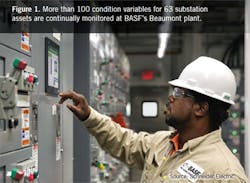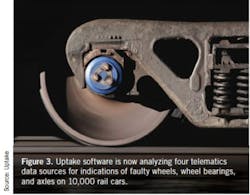6 case studies illuminate the value of predictive and prescriptive maintenance
Maintenance and reliability best practices are continually improving and so are the technologies that support them. Firmly embedded in the realm of the “best” is predictive maintenance (PdM), which combines real-time monitoring of asset condition, environmental, and/or operational data with smart analytics to detect, assess, and forewarn of impending problems.
Prescriptive maintenance (RxM) takes PdM a step further by prescribing corrective actions for deteriorating conditions and including them in the alerts. RxM is a newer concept just gaining ground that is made possible by machine learning (ML), artificial intelligence (AI), and the internet of things (IoT).
“Preventing dreaded unplanned downtime provides a clear business benefit and driver for adoption of PdM,” said Ralph Rio, vice president at ARC Advisory Group. “Unplanned downtime often cascades into major losses including revenue, WIP materials, and larger equipment repair costs.”
Additionally, the costs for implementation and support of a PdM application have dramatically lowered with the IoT, cloud platforms, microservices for analytics, and wireless sensors, Rio observes. “Clear benefits and lower costs have improved financial justification and driven adoption in a wide range of industries,” he added.
The six case studies summarized below illustrate some of the numerous ways PdM and RxM are transformative.
1. BASF / Schneider Electric
BASF, the largest chemical company in the world, has digitalization as a corporate strategy. This includes using data to better forecast maintenance requirements and reduce unexpected shutdowns.
One such initiative involved an electrical infrastructure expansion at BASF’s Beaumont, TX, plant. Since production efficiency depends on having predictable electrical power, the plant chose to enable remote monitoring and management of its new power distribution substation’s operations and asset health with EcoStruxure Asset Advisor from Schneider Electric. The data-driven, IIoT-enabled service employs asset sensors for continuous condition monitoring along with predictive analytics to identify threats that could lead to asset failures.
BASF also has access to customized, proactive advice about how to prevent failures and improve its maintenance strategies through its partnership with Schneider Electric’s Connected Services Hub (formerly Service Bureau).
The use case involved having more than 100 condition variables continually collected, measured, and computed for 63 substation assets. The asset data is monitored and analyzed from a digital dashboard that provides 24/7 insight into the substation’s global health index and specific asset statuses, from any location.
“We were surprised by some of the things that we found out. Asset Advisor is helping us to prevent catastrophic failures,” said Lee Perry, electrical design engineer at BASF. The cloud-based service “connects assets so we can look at the health of not just our electrical distribution equipment, but also the motor control centers and the motors that actually drive the process,” he explained.
“If there’s an issue, then we get an email from the Service Bureau saying, ‘We’re noticing this.’ I can log in to it remotely, look at the same information, and help troubleshoot that issue,” added Perry.
With around-the-clock access to data and expert guidance, the plant has the information it needs to make the right decisions at the right time, perform PdM to optimize asset health, and take steps to improve the efficiency of critical electrical distribution assets. These actions consequently benefit plant uptime, performance, productivity, and safety.
2. ALCOA / Senseye
PdM is a key part of Alcoa’s strategy to become a more stable and profitable organization. To help automate PdM and reduce downtime and maintenance costs, a proof-of-concept (POC) project involving 50 assets across two casthouse systems was conducted at its Fjar∂aál aluminum smelter in Iceland. The solution is now being expanded to at least 1,000 assets in Fjar∂aál and is scalable enterprise wide.
Senseye was chosen to unify and synchronize the equipment sensor data in the plant’s OSIsoft PI ecosystem with maintenance data in its Oracle eAM solution. From the current and historical ingested data, it automatically builds models and starts learning, without having to set up parameters or alarm levels. Isolated peaks in raw data create signatures that reveal trends and hidden failures. Predictive analytics identify what is happening and why, and can provide prognostic insights on the asset’s remaining useful life.
Operators are automatically notified of cases needing attention and can drill down for further details. It is “like having a thousand eyes in the plant” letting you know when data streams start to move away from normal, explained Árni Einarsson, reliability implementation manager at Alcoa in his presentation at OSIsoft PI World San Francisco 2020.
For instance, an idling current increase provided an indication of a fault in the HDC saw motor system. It was determined a belt guard had come loose and was in contact with the sawing drive, damaging the belt. Replacing the belts and fastening the belt cover during a maintenance shutdown resolved the issue, avoiding 12 hours of unplanned downtime.
A sensor failure detected in a coiler rod cropping shear motor prompted the discovery that a lower pinch roller sensor had come loose, leading to a sharp increase in shear motor torque. Re-fastening the sensor returned the torque to normal levels, avoiding three hours of unplanned downtime.
In total, Alcoa reduced unplanned downtime of the machinery by up to 20 percent and achieved full ROI in 4-6 months. “With the POC completed, we were able to scale the solution to other parts of the business,” said Einarsson. “The focus is on finding the best business cases to continue.”
3. Duke Energy Renewables / Seeq
Duke Energy Renewables, an owner/operator of wind and solar farms across the U.S., used advanced analytics and ML to automate profiling and detection of failing contactors on one of its wind turbines. “This was a trial run with one use case that was interesting, the data was available, and it seemed like a good candidate. We wanted to get up and running fast and to see if this even works for us,” said Abhi Hullatti, manager of performance analytics at Duke Energy Renewables, in his presentation at the ARC Industry Forum Orlando 2020.
Hullatti described how each turbine has six contactors that help to ensure that when the generator kicks in, it ramps up smoothly and synchronizes with the electrical grid. When any of the six contactors fail, the turbine goes offline for 2-10 days for diagnosis and repair. Turbine contactors at one site tended to fail more frequently than at others. Automating the prediction of impending failure would enable PdM, improve uptime, reduce maintenance costs, and allow better management of spare parts inventory.
Using an automated profiling tool from Seeq, a model was trained to look for the contactor fault error code and plausible leading-indicator signals (reactive power, active power, current, wind speed, rotor speed, and generator speed), to recognize what normal behavior looks like, and to provide one-hour advance notification of a fault.
The model ran against 2.5 years of cleansed signal data for the turbine and it found 12 occurrences of the error code, mostly within the few months preceding a failure. There were no false positives leading up to that outage, and no further error codes or predictions followed once all the contactors were replaced. The model can run continuously once it is validated and it will give automatic notification when something is going wrong, said Hullatti.
“The results are extremely promising, so we want to next expand this model to the rest of our turbines at that site, and also, more interestingly, look at other failure modes. That will be a lot more complex but also far more financially rewarding,” observed Hullatti. The return on the ability to catch a generator that is about to fail, and act proactively instead of reactively, is in the hundreds of thousands of dollars per event, he explained.
4. Global Mining Company / Uptake
A leading global mining company needed to predict and prevent failures that can cause unplanned downtime in its material transport operations. The company owns and operates a network of private railway tracks, rolling stock, and signals that move iron ore from its mining sites to the seaport. Any faults, delays, or breakdowns in the process of moving the high-value material is not only costly from an equipment maintenance and operational performance perspective, but it can also be potentially catastrophic.
The trains and rail infrastructure already produce immense amounts of data from wayside telematics devices. If harnessed, the Wheel Impact Load Detection (WILD), Wheel Condition Monitoring (WCM), Hot-Box Temperature Detection (HBD), and Bearing Acoustic Measurement (BAM) data could provide operational and condition insights into anomalies with sufficient time to take corrective actions.
The mining company chose Uptake, an industrial AI software company, to provide the necessary visibility into degrading asset conditions across the network and advanced analytics to prescribe recommended solutions. The software is now analyzing the four telematics data sources for indications of faulty wheels, wheel bearings, and axles on 10,000 rail cars.
Events are ranked according to criticality. Each high-severity wheel or bearing downtime event for a rail car costs the company at least $6,000 and requires immediate attention to return it to operation. Previously unforeseen, the mining company now has roughly a weeks’ advance notice on high-severity wheel alerts, 11 days’ notice of high-severity bearing alerts, two weeks on medium-severity alerts, and a month on opportunistic events.
With the advanced notice of issues and prescriptive alerts, the company can proactively bundle its maintenance activity, significantly reducing downtime and avoiding rail car failure. As a result, it is able to reduce its single-car unscheduled maintenance events by an estimated 50 percent, from 1,850+ per year to 925+ per year, which represents approximately $34 million in savings over five years.
5. Cement Plant / Aspentech
A cement plant that had struggled with cyclone blockage in its cement kilns was one of several PdM case studies shared by Chris Williams, global director of asset performance management (APM) services for AspenTech, at his ARC Industry Forum Orlando 2020 workshop. Frequent blockages in filters and cyclones limit production and increase maintenance costs, he explained. Subtle changes in the preheater process can eventually lead to blockage.
To reduce downtime and optimize maintenance, the plant sought a solution to predict and avoid cyclone blockages through early and accurate detection. Having the added benefit of RxM capabilities to resolve emerging problems quicker would minimize production losses.
The cement plant chose a PdM and RxM solution with AI and ML capabilities from AspenTech. Maestro for Aspen Mtell was used to build enhanced agents capable of predicting cyclone blockages. The failure agents trained on past blockages to identify the failure signatures that precede degradation, breakdowns, and process disruptions, and learned to recognize the pattern.
The multivariate (MV) models helped the plant to better understand the root cause of the condition and provided prescriptive guidance on feed composition and kiln operating conditions to the operators, enabling them to quickly bring the process back to normal operation. Within weeks, the solution was able to provide several days of early warning. “Eliminating just 25 percent of blockages generated over $1 million in savings,” said Williams.
6. Wärtsilä / Pega
Wärtsilä, a Finnish technology and service provider for energy and marine markets around the world, needed to improve its ability to process and analyze asset condition data received daily from thousands of equipment installations. An IoT engine upgrade was needed to help preempt performance issues with its customers’ power plants and vessels, and to automate feedback to each customer. Its legacy system could not sufficiently scale to handle the desired automation.
Many of Wärtsilä’s installations have multiple engines per site, and each engine has attached equipment and hundreds of sensors generating condition-based data. To better harness the global data, the company needed to map it to a normalized data structure for quick processing and apply a rules framework to assess the sensor data for anomalies. This would enable PdM practices to preempt equipment failures and also help to optimize service support.
The company worked previously with Pega on other projects and chose the Pega Platform to extend its existing IoT capabilities. The digital transformation platform for Digital Prescriptive Maintenance is designed to help optimize the cost and duty-cycle of devices and systems.
With the new IoT-powered solution, Wärtsilä now compiles all incoming sensor data in a data lake in the cloud, where it is normalized and fed into the Pega Platform. Using a complex rules framework, the data is processed to identify exceptions that may indicate a developing risk of engine failure or a reduction in equipment performance. Daily feedback reports document the findings and prescribe recommended actions, enabling the company to save time and money by avoiding unplanned downtime and production problems.
Benefits to the customers include improved environmental and economic performance and long-term predictability of their vessels or power plants. Wärtsilä is also benefitting from optimized equipment maintenance, improved reliability and performance, and increased sales of proactive maintenance contracts.
Each of these industry leaders is enjoying the rewards of using maintenance and reliability best practices. With the benefits of PdM and RxM being realized, the old ways of doing business seem antiquated and companies like these are not looking back.
About the Author

Sheila Kennedy
CMRP
Sheila Kennedy, CMRP, is a professional freelance writer specializing in industrial and technical topics. She established Additive Communications in 2003 to serve software, technology, and service providers in industries such as manufacturing and utilities, and became a contributing editor and Technology Toolbox columnist for Plant Services in 2004. Prior to Additive Communications, she had 11 years of experience implementing industrial information systems. Kennedy earned her B.S. at Purdue University and her MBA at the University of Phoenix. She can be reached at [email protected] or www.linkedin.com/in/kennedysheila.



